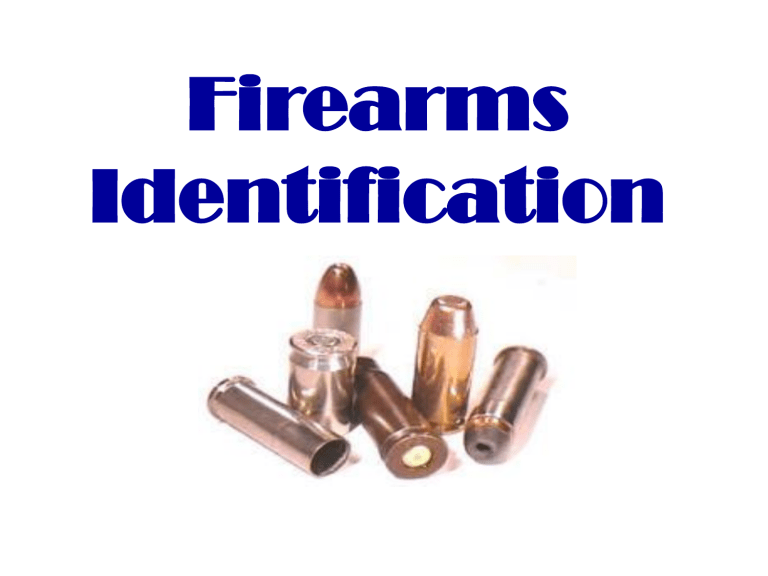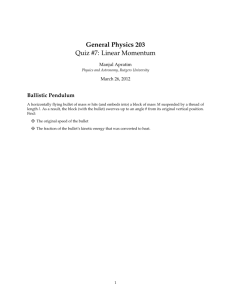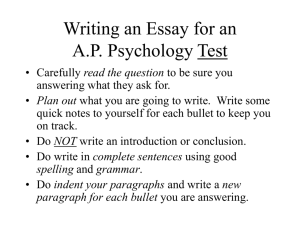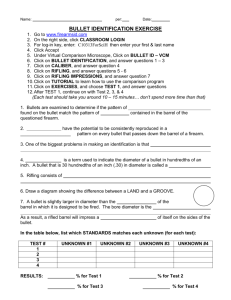Firearms and Ballistics Powerpoint

Firearms
Identification
Firearms Identification
A discipline mainly concerned with determining whether a bullet or cartridge was fired by a particular weapon.
3 Areas of Interest
• Internal ballistics
• What happened when the gun is fired?
• External ballistics
•What happened to the bullet and residues outside of the gun?
• Terminal ballistics
•Where did the bullet go?
Primer
Anatomy of a Bullet
Cartridge Case
Lead Bullet
Gun Powder
#1 The expanding _____ generated by the burning of gunpowder propels the bullet forward through the barrel.
A.Liquid water
B.Solid primer
C.Gases
Anatomy of a Firearm
Breech
Extracting
Pin
Firing Pin
Ejector (not shown)
Breech
When a cartridge is fired, the explosion forces the bullet down the barrel and the shell casing is forced back against the breech . This leaves impressions unique to the individual gun’s breech on the shell casing.
Broach Cutter
Rifling
The spiral grooves that are formed in the bore of a firearm barrel. Makes projectile spin when fired.
#2 What is the benefit of using a firearm that is rifled?
A. The bullet will be fired with greater accuracy
B. The bullet will be fired faster
C. The bullet will not be damaged when fired
Shotgun identification
Shotguns have smooth barrels with no rifling.
Therefore there are no land or groove marks left on the bullet. Identification can still be made by comparison of extractor/ejector markings on shotgun shell.
B
B
A
B
A
Barrel
A ) Land
B ) Groove
Rifling Impressions on a Bullet
A ) Land impression
B ) Groove impression
#3 True or False.
Since manufacturers typically use a broach cutter that impresses the same number of lands and grooves on a barrel, then all guns made by a company are identical.
A. True
B. False
A ) Land impression
B ) Groove impression
B
A
#4 Given the image of the bullet below, what conclusion can be drawn.
A. This bullet has not been fired from a weapon
B. This bullet was fired from a rifle or handgun.
C. This bullet was fired from a shotgun.
A
Caliber - the diameter of the bore of a rifled firearm. The caliber is usually expressed in hundredths of an inch or millimeters. Example .22 caliber or 9mm.
#5 Caliber is measured from:
A.Land to groove
B.Land to land
C.Groove to groove
Bullet Comparison
Class Characteristics
Different gun manufacturers use different rifling techniques. These techniques impart the class characteristics of a bullet.
-Brand
-Size
-Number of lands and grooves
-Width of lands and grooves
-Depth of lands and grooves
-Pitch
-Twist
Bullet Comparison
Individual Characteristics
• A cross section of a gun barrel will show small grooves or striations all along the lands and grooves
(machine markings)
• These are created when the barrel is rifled.
A
Bullet Individual Characteristics
B
#6 Which of the following is not a class characteristic of bullets.
A. Number of lands and grooves
B. Width of lands and grooves
C. Striations
D. Pitch
E. Brand and size of the bullet
Cartridge Case Class Characteristics
Manufacture ( i.e.. Winchester)
Shape ( i.e.. rimless, rimmed )
Caliber ( i.e.. 45 ACP, 9mm, 12gauge)
Composition ( i.e.. brass, steel, plastic)
Cartridge Case Individual Characteristics
Firing Pin Impressions
Breech Face Marks
Ejector Marks
Extractor Marks
Breech
Extracting
Pin
Firing
Pin
Examples of Breech Markings
Firing Pin Marks
Breech Marks
Firing Pin Mark
Extracting Pin and Ejector Marks
The extracting pin and ejector throw the spent shell casing from the chamber of the gun.
These leave marks on the shell casing that are unique to those parts on that particular firearm.
#7 Which of the following is not an individual characteristic of cartridge cases.
A. Firing pin impressions
B. Caliber
C. Breech face marks
D. Ejector marks
#8 Given the image of the cartridge cases, what conclusion can be drawn.
A. A cartridges have not been fired from a weapon
B. B cartridges have not been fired from a weapon
C. Both A & B have been fired
D. Neither A nor B have been fired
A B
Standards Comparison
A submitted firearm will be fired several times using a water tank, boxes of cotton, or tubs of gelatin to obtain standards from the firearm.
#9 Standards for bullets and cartridge casings are obtained by:
A. Photography and casting
B. Firing test bullets into water, cotton, or gelatin
C. Collecting evidence from the crime scene
Comparison Microscope
• Does the caliber of the bullet match caliber of the firearm?
• Do the rifling impressions on the bullet match the pattern in the barrel?
• Do the striation patterns match between the suspect bullet/barrel and the standard bullet/barrel?
A – CS bullet
B – Std. bullet
#10 Given the image of the bullets above, what conclusion can be drawn.
A. Bullets A & B were fired from the same weapon
B. Bullets A & B were fired from different weapons






